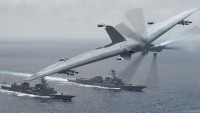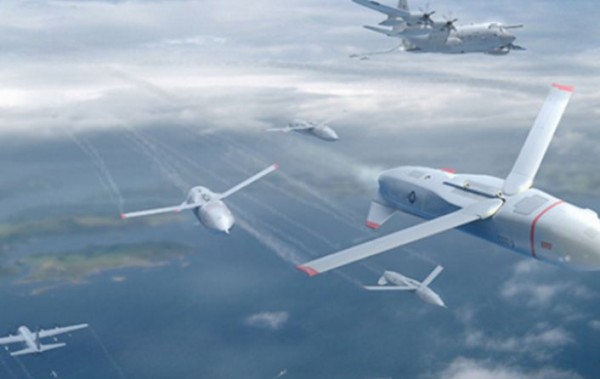DARPA is Funding Research into Mind-controlled Drone Swarms
| Arthur Dominic Villasanta | | Jul 20, 2016 10:00 PM EDT |
(Photo : DARPA) DARPA mind-controlled gremlins on the attack
A mass of unmanned aerial drones attacking enemy targets and controlled by the mind of a single soldier is the end point of an ambitious research program being funded by the U.S. Defense Advanced Research Projects Agency or DARPA.
A new but unspecified advance in mind-controlled drone swarms was made recently at Arizona State University (ASU). This brings the program a step closer to the point a single operator can operate multiple flying and ground-based drones using his thoughts.
Like Us on Facebook
Panagiotis Artemiadis, director of the Human-Oriented Robotics and Control Lab at ASU, said research began with the idea of human swarm interaction.
"We record it from the brain," he said. "We actually saw that the brain really cares about collective behaviors of swarms and now we know where to record from and what to see from the brain signals in order to decode that to collective behaviors for aerial vehicles and swarms of robots."
Artemiadis, an assistant professor of mechanical and aerospace engineering at ASU, has been working on linking the human brain with machines since 2009.
He's been working on mind-controlled drone swarms for the last two years with funding from DARPA, which is developing its own aerial drone swarms for use in war under its Gremlins program.
So far, Artemiadis and his team have displayed limited mind-control of both flying and ground-based drones simultaneously. The team will expand its research to include multiple swarms under the control of multiple people.
Artemiadis sees the mind-controlled drones "performing complex operations such as search-and-rescue missions."
"The goal for the next couple of years is to actually have now a hybrid team of both ground vehicles, mobile robots and aerial vehicles -- quadrotors -- that will collaborate with each other," he said. "We want to do that with tens, even go to 100 robots."
Artemiadis' work will go a long way towards advancing DARPA's Gremlins program that seeks to illustrate the feasibility of conducting safe, reliable operations of multiple air-launched, air-recoverable unmanned systems.
Gremlins also aims to prove reusable systems can provide significant cost advantages over expendable systems, spreading out payload and airframe costs over multiple uses instead of just one.
An ability to send large numbers of small unmanned air systems (UAS) with coordinated, distributed capabilities can provide U.S. military forces with improved operational flexibility at much lower cost than is possible with today's expensive, all-in-one platforms -- especially if those unmanned systems could be retrieved for reuse while airborne. Gremlins intends to attain this aim.
"Our goal is to conduct a compelling proof-of-concept flight demonstration that could employ intelligence, surveillance and reconnaissance (ISR) and other modular, non-kinetic payloads in a robust, responsive and affordable manner," said Dan Patt, DARPA program manager.
The program envisions launching groups of gremlins from large aircraft such as bombers or transport aircraft, as well as from fighters and other small, fixed-wing platforms while those planes are out of range of enemy defenses.
When the gremlins complete their mission, a C-130 transport aircraft will retrieve them in the air and carry them home, where ground crews would prepare them for their next use within 24 hours.
Tagsmind-controlled drone swarm, Defense Advanced Research Projects Agency, DARPA, Panagiotis Artemiadis
©2015 Chinatopix All rights reserved. Do not reproduce without permission
 DARPA Seeks to Automate US Defenses against Cyberattacks on the Internet of Things
DARPA Seeks to Automate US Defenses against Cyberattacks on the Internet of Things DARPA's TERN Drone will Transform US Navy Warships into Aircraft Carriers
DARPA's TERN Drone will Transform US Navy Warships into Aircraft Carriers DARPA Moving Fast to Replace US Stealth Fighters with Hypersonic Fighters
DARPA Moving Fast to Replace US Stealth Fighters with Hypersonic Fighters Future American Soldiers will be True Cyborgs, Thanks to DARPA
Future American Soldiers will be True Cyborgs, Thanks to DARPA DARPA Wants to Weaponize the Internet of Things to Save U.S.
DARPA Wants to Weaponize the Internet of Things to Save U.S.
EDITOR'S PICKS
-

Did the Trump administration just announce plans for a trade war with ‘hostile’ China and Russia?
-

US Senate passes Taiwan travel bill slammed by China
-

As Yan Sihong’s family grieves, here are other Chinese students who went missing abroad. Some have never been found
-

Beijing blasts Western critics who ‘smear China’ with the term sharp power
-

China Envoy Seeks to Defuse Tensions With U.S. as a Trade War Brews
-

Singapore's Deputy PM Provides Bitcoin Vote of Confidence Amid China's Blanket Bans
-

China warns investors over risks in overseas virtual currency trading
-

Chinese government most trustworthy: survey
-

Kashima Antlers On Course For Back-To-Back Titles
MOST POPULAR
LATEST NEWS
Zhou Yongkang: China's Former Security Chief Sentenced to Life in Prison

China's former Chief of the Ministry of Public Security, Zhou Yongkang, has been given a life sentence after he was found guilty of abusing his office, bribery and deliberately ... Full Article
TRENDING STORY

China Pork Prices Expected to Stabilize As The Supplies Recover

Elephone P9000 Smartphone is now on Sale on Amazon India

There's a Big Chance Cliffhangers Won't Still Be Resolved When Grey's Anatomy Season 13 Returns

Supreme Court Ruled on Samsung vs Apple Dispute for Patent Infringement

Microsoft Surface Pro 5 Rumors and Release Date: What is the Latest?










